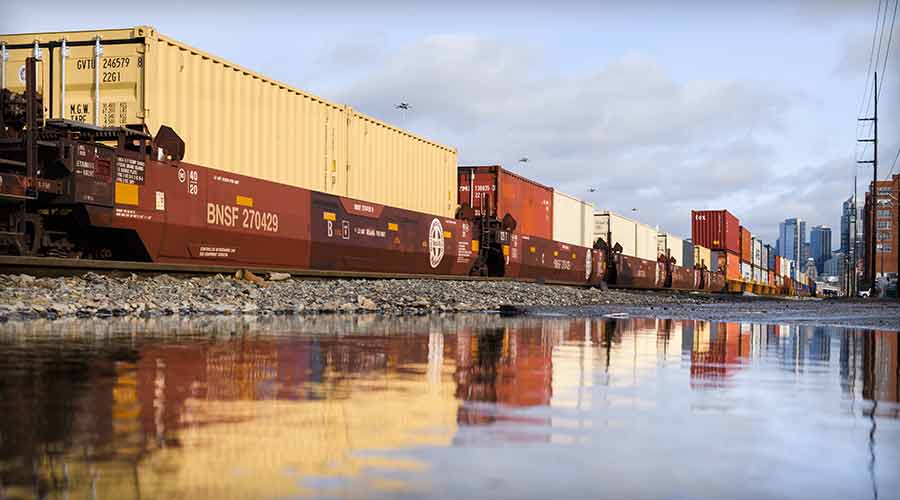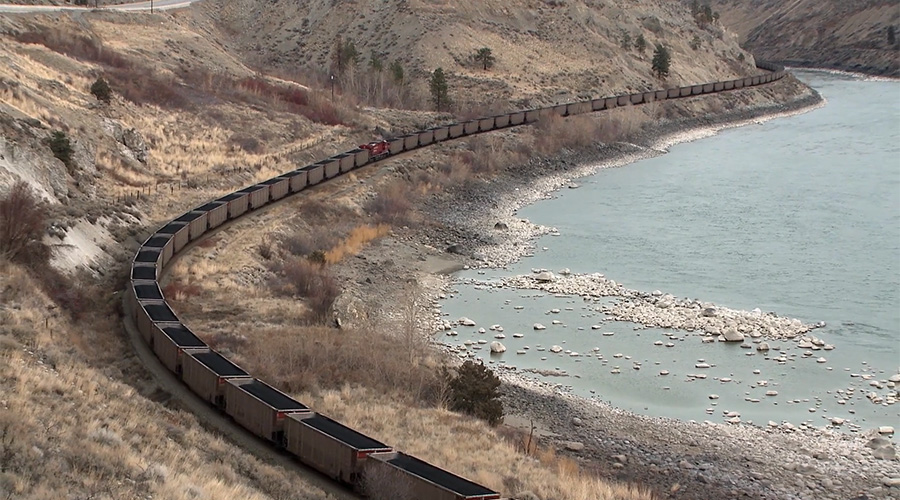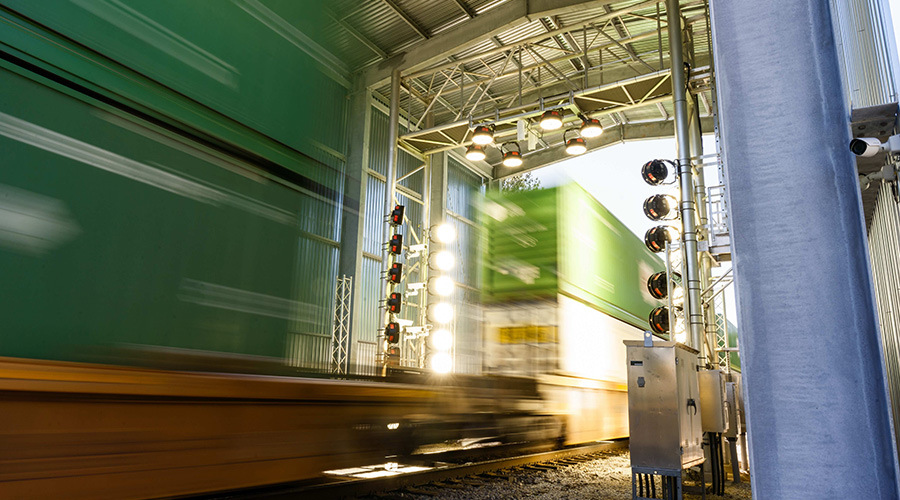Rail, truck, port sectors seek high-tech solutions to modernize the supply chain
10/10/2022
By Julie Sneider, Senior Associate Editor
The role of new technology in meeting myriad challenges to the domestic and global supply chains is paramount. To that end, the Eno Center for Transportation offered a webinar last week featuring representatives from the rail, port and trucking sectors discussing their industries’ latest innovations to address objectives related to safety, decarbonization and efficiency.
Moderated by Eno Chief Finance Officer and Policy Director Paul Lewis, the webinar offered glimpses into the future from Kari Gonzales, president and CEO of MxV Rail (formerly TTCI Inc.); Cary Davis, vice president of government relations and general counsel of the American Association of Port Authorities (AAPA); and Kevin Grove, director of safety and technology policy at the American Trucking Associations (ATA).
Lewis kicked off the event by asking each speaker to describe new things in their respective sectors that are changing the efficiency, safety and dynamics of freight transportation. Gonzales said the webinar’s timing was perfect because modernization is essential to enhance the safety, reliability and efficiency of freight-rail transportation.
For example, railroads are deploying drones and automated track inspection systems along their networks to look for flaws in rolling stock; using Trip Optimizer Systems (made by Wabtec Corp.) to enhance fuel efficiency; and looking to “layer” new technology on the foundation of GPS-based positive train control (PTC) systems, which railroads installed and implemented to prevent the worst kind of train accidents.
“PTC was fully implemented in 2020 and we believe we are seeing the fruits of that system already,” Gonzales said. “The industry views this system as one that can be layered on to help accelerate automation. The net impact is safer operations and, potentially, to increase capacity on our network without having to physically add new infrastructure — which is continually a challenge for the entire United States.”
 “Not only are you getting safety improvements by sharing data, you are getting better reliability through the network.” — Kari Gonzales, MxV Rail MxV Rail
“Not only are you getting safety improvements by sharing data, you are getting better reliability through the network.” — Kari Gonzales, MxV Rail MxV RailAAPA’s Davis talked about three technological breakthroughs that have occurred in the maritime shipping industry: the invention of the steamship in the 19th century; the evolution of containerization in the 1960s and 1970s; and, now, the application of data to the supply chain.
“We’re trying to get better data to track not only the goods moving on the supply chain, but also to use or digitalize the data on the system,” he said.
Currently, the federal government is incentivizing ports to adopt digital transparency via two initiatives: the Freight Logistics Optimization Works (FLOW) project; and the Maritime Transportation Data Initiative. Launched in March by the U.S. Department of Transportation, the FLOW project is developing a digital tool that gives companies information on the condition of a node or region in the supply chain so goods can be moved more quickly and cheaply. The project now has 36 participants that have begun sharing data with the USDOT for the first time, according to the department’s website.
Davis also mentioned the Maritime Transportation Data Initiative, which launched early this year and is led by Maritime Commissioner Carl Bentzel. That project is focused on cataloging maritime data elements, metrics, transmission and access; identifying key gaps in data definitions and classification; and developing recommendations for common data standards and policies.
IIJA will help fund modernization
Also, the Infrastructure Investment and Jobs Act (IIJA) — the new, $1.2 trillion federal law passed by Congress in late 2021 — is sure to have a major impact on modernizing ports. The legislation includes $17 billion to improve waterways and address repair and maintenance backlogs, reduce congestion and emissions and drive electrification and other low-carbon technologies at U.S. ports.
“We are reinvigorating aging infrastructure, expanding capacity, building up port complexes and warehouses, adding newer equipment and investing in our freight system like it’s a multimodal system,” Davis said.
And it’s not just docks, pilings and piers that are being reinvigorated under the IIJA — it’s also device data and information technology; ocean and waterway mapping technology for more efficient dredging and navigation around ports; advanced construction materials that hold up in natural disasters; and “next- generation bunkering” and the decarbonization of fleets so they are no longer running on heavy diesel fuel, Davis said.
Regarding the latter, more vessels will be operating on liquefied natural gas (LNG), he said.
“Ten to 20% of all vessels being built now will be fueled by LNG,” said Davis. “Ocean carrier Maersk has 12 container ships on order to run on green methanol.”
And in a back-to-the-future example, Davis described one “well-established ocean carrier” building a vessel to be partially powered by advanced sails.
“So, we’ve come full circle to the 1800s and wind-powered ships,” he added.
When it comes to the future of trucking, automation remains the hot topic. As a result of the IIJA, driver assistance systems — such as automatic emergency braking and inspection systems — will continue to evolve and some will become standard on trucks, said ATA’s Grove.
 “We’re trying to get better data to track not only the goods moving on the supply chain, but also to use or digitalize the data on the system.” — Cary Davis, American Association of Port Authorities LinkedIn
“We’re trying to get better data to track not only the goods moving on the supply chain, but also to use or digitalize the data on the system.” — Cary Davis, American Association of Port Authorities LinkedIn “The whole area of driverless automation is being tested heavily in the United States right now,” Grove said.
The question isn’t when driverless technology will become more prevalent, but where.
“It’s going to be coming sooner than a lot of people think,” Grove said. “It will come where there’s an additional need for capacity on our transit network. It’s where we need more drivers or in the long-haul sector where it’s hard to recruit drivers to drive long distances. Or, where the hours-of-service rules are making certain trips hard to make in one 14-hour block.”
Electric vehicles and alternative fuels also are being explored, according to Grove. Additionally, a combination of different technologies is being deployed to improve trucking safety and efficiency, he added.
“Fleets are learning how to utilize and improve their operations, train their drivers better and get a lot better outcomes by combining the technology and using the data that comes off of it,” said Grove.
Data: Who owns it, who has to share it?
One policy question in play relating to data: Who owns the data that should or needs to be shared?
“We can think of infinite uses for data, but that ownership will determine how it will be used and then ultimately [accessed] by the public sector,” ENO’s Lewis said.
On the port side, the easy answer is who owns the cargo moving through the system, according to Davis.
“The beneficial cargo owners — we call them BCOs — they own the data about their cargo,” Davis said. “In many cases, they may not realize how those data are being aggregated. But … if we want to move to a reliable, standardized, transparent supply-chain data system, cargo owners are probably going to have to give up ownership rights for some of that data.”
In railroading, the answer depends on what data is being viewed, said Gonzales.
“There are different tiers of data and visibility,” she said. “If you’re looking at the end-to-end data from a rail car traveling across the nation — asking where is that rail car — that data is a bit more visible to the consumer and shipper.”
From a safety perspective, a lot of data is generated by individual railroads and then filtered through to an industry-wide system that “helps us make good safety decisions,” she said.
“One example for safety and reliability is the hot-bearing detection system to monitor the temperature of a bearing as a rail car passes the inspection testing system,” she said. “Fifteen years ago, those were placed strategically across the United States, but looked at independently. That resulted in a lot of stops on trains and potentially some missed applications.”
But five to eight years ago, such data was moved to a connected network where it can be shared, predictive analytics applied to determine potential failures and cars in need of repairs are removed from service.
“So, not only are you getting safety improvements by sharing data, you are getting better reliability through the network,” Gonzales added.
Lewis wrapped up the webinar by inquiring about the barriers to modernization that railroads, ports and trucking companies are facing. Both Gonzales and Grove raised pending government regulations as a challenge to some technological improvements that their respective industries wish to make.
Davis noted the “Buy American” provisions in the IIJA will present a quandary for ports to use federal funding to procure modern cargo moving equipment, such as rubber-tired gantry cranes.
“Many of the most modern pieces of equipment like cranes are not made in America and haven’t been for a generation,” said Davis. “We have to convince the government for a short period of time to let us get the best, fastest and most modern equipment from our allies and then, hopefully, re-shore the manufacturing of that equipment.”


